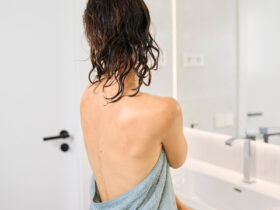This article was previously published July 3, 2020, and has been updated with new information.
In this 13-minute video from 2020, Peggy Hall from The Healthy American offers evidence that cloth face masks may not be as effective as people believe. Conflicting advice over whether the use of face masks is an effective public health strategy has been ongoing since the start of the pandemic, but as 2022 dawned and the Omicron variant raged, yet another “official” mask recommendation came down from the U.S. Centers for Disease Control and Prevention.
There are three choices with face masks.1 The first are surgical masks, also called medical masks, and they’re disposable. Some have a metal band across the top that can be bent to fit around the wearer’s nose. They filter out large particles and can protect your face from splashes and sprays.
A second option is an N95 mask, which is a type of respirator. This type is capable of filtering small and large particles. Some have valves on the side, which make breathing easier, but the valves release unfiltered air.
This means the wearer may spread viruses. N95 masks are used more frequently by health care providers who must pass a fit test to confirm the mask provides an adequate seal. They are designed to be disposable.
Because the sudden demand for face masks made them hard to find, people got creative in the design and production of cloth masks. These can be washed and reused. However, the efficacy of these types of mask is dependent on the material used, and some experts said cloth masks were not effective.2 Now, in 2022, health officials say cloth masks don’t provide enough protection, and that you should opt for an N95 or KN95 mask instead.3
Cloth Masks Reduce Oxygen Supply
I’ve written many articles on the pros and cons of face masks, but as more public gyms and fitness centers open, and as schools go back to in-person learning, the question of whether a mask should be worn while working out is one you may be asking. In 2015, one team sought to compare the efficiency of cloth masks against surgical disposable masks in hospital health care workers. They engaged 1,607 full-time health care workers whose duties were performed in high-risk units.4
The participants were randomized to wearing medical masks or cloth masks. Researchers who conducted the first randomized control trial using cloth masks cautioned against the adoption of cloth masks by health care workers and said, “Moisture retention, reuse of cloth masks and poor filtration may result in increased risk of infection.”5
In March 2020,6 the team published a response to their work in light of the COVID-19 pandemic. They wrote that in the original study, they found that health care workers using cloth masks had a higher rate of infection. Yet, the physical barrier may offer protection, although less than a medical mask. They concluded, “Finally for COVID-19, wearing a mask is not enough to protect health care workers …”
As Hall demonstrated in the video, people wearing a mask are also breathing oxygen levels below what OSHA defines as safe: “Oxygen deficient atmosphere means an atmosphere with an oxygen content below 19.5% by volume.”7
Reducing your oxygen intake raises your CO2 levels. For most people, signs of discomfort will happen sooner rather than later. Your body requires a healthy balance of CO2 and oxygen for optimal health.8 When a person breathes more than is needed, they deplete their levels of CO2.9 One measure of physical health is your CO2 tolerance.
Dr. Konstantin Buteyko devised a method of determining your CO2 level using a simple test you can do at home. The result of the test is called a “control pause.” He writes, the “majority of contemporary people have control pause within 20 to 40 seconds” but healthy individuals should have a control pause of 40 to 60 seconds.
Gyms Working to Reduce Infection
This may explain, in part, why some people have more difficulty wearing a mask while others do not. Medical professionals often wear masks for hours during surgery or when taking care of individuals with immune deficiencies. But, wearing a mask while standing or walking slowly is a far cry from wearing a mask while driving up your body’s oxygen needs.
Requiring face coverings is just one of the precautions fitness centers and schools are taking across the U.S. as we move into the pandemic’s third year. Many are also still doing temperature checks as participants come inside; smaller class sizes, sanitizing stations and moving their desks and machines farther apart are also components of many open-up plans.10 These precautions are aimed at reducing potential exposure in a confined area.
While some schools are mandating masks for both indoor and outdoor sports,11 most gyms are leaving the choice of wearing a mask to the individual. Some who are used to wearing surgical masks on the job, however, have struggled while exercising with cloth mask coverings. In a conversation with a USA Today reporter, pharmacist Victoria Williams described her experience at Orangetheory Fitness:12
“I struggled to work out in a homemade mask. I would just try and be good about breathing in through the nose and out through the mouth to forcefully push the mask back off of my face with that exhale.”
Rachelle Reed is the director of global fitness science for the organization. She believes that by encouraging exercisers “to listen to their bodies and track their physiological data to adjust intensity levels,” they have found a balance between safety and fitness.
USA Today reports that when the Knoxville location of Orangetheory Fitness opened May 7, 2020 it required everyone to wear masks.13 By May 25, the fitness center had eased the rules so that only individuals attending certain classes were required to wear them. By June 1, 2020, masks had become optional for the whole studio.
Exercising Without Adequate Oxygen Is Dangerous
Some people have suffered dangerous and even lethal consequences from wearing a mask while exercising. When levels of carbon dioxide rise too high, it can initially trigger symptoms such as headaches, fatigue, poor concentration, nausea and breathing difficulties.14
When pushed further, worse things begin to happen. A 26-year-old man from Wuhan, China, was hospitalized with chest pain after completing his 6k run while wearing a mask. Although he reported having difficulty breathing, he pushed himself to cover the distance.15
After getting home and having ongoing chest pain, he was taken to the hospital. Doctors diagnosed a collapsed lung, which had shrunk by 90%. The chief medic at the hospital, Dr. Chen Baojun, suggested the man’s physique made him more susceptible as he was “a very tall man and quite thin.”16 The Mirror reported:17
“… the face covering directly caused the sudden increase of pressure to Mr. Zhang’s lung due to intense running.”
In light of the news that several Chinese school children died in physical education classes while wearing masks, more than one educational bureau began rethinking their policies.18 In late April 2020, two schoolboys collapsed and died within one week of each other. They were both 14 years old and were participating in a required physical examination test.19
During the peak months of COVID-19, children in China were studying online and staying home. Results from a recent survey indicate that more than 70% reported putting on weight during the lockdown.20
In response, one middle school in China started requiring 100 minutes of running each day to get the students back into shape. High school students normally take a national physical fitness exam, but these have recently been canceled in some areas.21
Exercising With a Face Shield May Be More Effective
When your criteria are to reduce exposure to infectious diseases and maintain optimal oxygenation, if you must wear something on your face, a face shield has distinct advantages over cloth masks during exercise. Face shields are plastic covers that go over the whole face and protect your eyes, nose and mouth from droplets.
There is an opening at the bottom, which means airborne viruses can still be inhaled; this is similar to what happens with cloth and surgical masks that do not have a seal. Face shields can be cleaned with soap and water or disinfectants and they can be used over and over. Because they are plastic, they do not degrade.22
On hot days and during exercise, they are also far more comfortable to wear and allow free breathing. More importantly, face shields protect your eyes, which are another entryway for the SARS-CoV-2 virus that face masks do not protect.
When face shields were studied against transmission of influenza, they protected people from immediately inhaling 96% of the droplets produced by an infected person.23 This level of protection was offered even when the individuals were just 18 inches apart. So, during exercise, when maintaining oxygenation is essential, a face shield may be your best option.
If You Wear a Face Mask Follow These Guidelines
There is evidence both for and against wearing face masks to stop the spread of infectious disease. However, it is likely safer to wear a face shield when exercising so you can meet your body’s increasing oxygen demand. If you do wear a face mask, consider these tips from the World Health Organization:24
- Before putting on a mask, clean your hands with soap and water.
- Cover your mouth and nose with the mask and make sure there are no gaps between your face and the mask.
- Avoid touching the mask while using it; if you have to, try to clean your hands with alcohol-based hand rub or soap and water before doing so.
- Replace the mask with a new one as soon as it is damp. Do not reuse single-use masks.
- To take off the mask: Remove it from behind (do not touch the front of the mask); discard it immediately in a closed bin; and clean your hands with alcohol-based hand rub or soap and water.












Leave a Reply